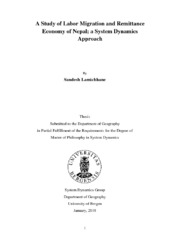A Study of Labor Migration and Remittance Economy of Nepal; a System Dynamics Approach
Master thesis

Permanent lenke
https://hdl.handle.net/1956/17784Utgivelsesdato
2018-02-03Metadata
Vis full innførselSamlinger
- Department of Geography [634]
Sammendrag
There is an increasing trend in emigration from Nepal to developed countries as a migrant worker since last two decades. With an increase in labor emigration there is increasing share of international migrant workers remittance on GNI of Nepal. It has become an area of interest for researchers and economists when the number of people emigrating and amount of inward remittance they send back started to increase. There is substantial debate regarding the relative contribution of inward remittance to sustainable economic development in remittance receiving countries. At the same time increasing labor emigration have different social, economic, political influence to both labor sending and receiving countries. Unavailability of job due to slower economic growth in comparison with increasing labor force entering to labor market and earning difference between Nepal and other labor welcoming countries are key factors influencing migration decision. Similarly, social network people have who are already working in different destination countries and reduction on migration cost due to social network also influence the migration decisions of many people who wish to emigrate as a migrant worker. Rapid increase in inward remittance can be observed to Nepal with an increase in labor emigration since last couple of decades. Officially recorded remittance inflow to Nepal has increased enormously over the last two decade, academic and policy oriented researchers have come up with different findings and conclusions regarding long term impact of remittance on economic growth of the country. However, there is no consensus over, whether remittance contribute to sustainable economic growth by reducing poverty, or weaken long term growth by creating the problem of labor shortage and brain drain. This research analyzes the current mechanism and structure of labor migration, remittance income and use, and how it is influencing economy of the country as a whole. Use of system dynamic approach , causal loop diagram, stock and flow diagram, simulation result from definitive modeling tool ‘Stella architect’ along with complex characteristics of structure of the system such as; time delay, non-linearity, feedback etc. are 4 the factors of this research which makes it unique from other research on same topic. After analyzing the past, present and future trend of different economic variables with the help of simulation result from the model, this study suggests that remittance can exert a weakly favorable impact on long term economic growth. This research also concludes that sustainable economic development can only be achieved with the presence of sound economic policies and institutions.